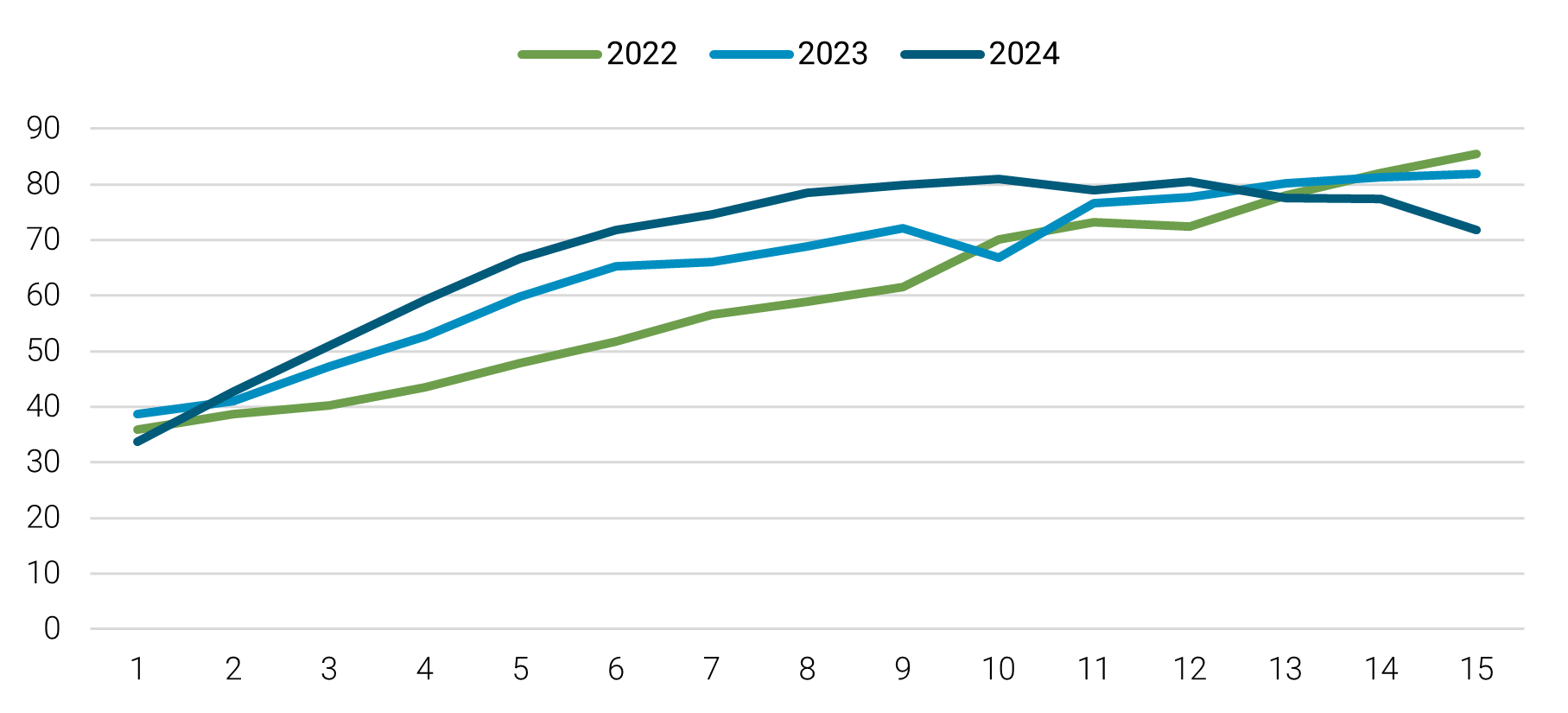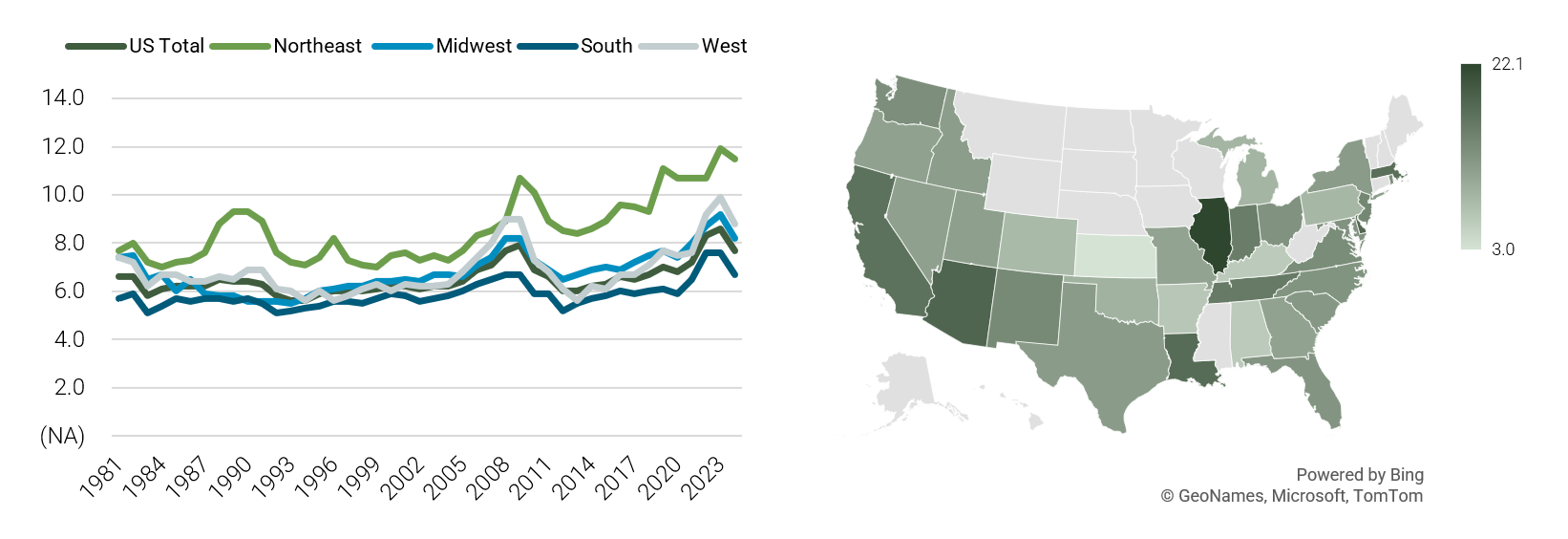How long does it really take to build a home?
November 7, 2025
Author: Roger Ashworth, Head of Research and Data
The time required to complete new single-family residential construction projects in the US sped up modestly in 2024. According to US Census data, it took 7.7 months on average to complete a single-family home, about a month faster than in 2023 (8.6 months). Homes built for sale remained the fastest to complete at ~6.3 months, while contractor-built and owner-built projects often extended to ~10.6 and ~13.7 months, respectively. Figure 1 provides the distribution of time to build single family homes across all three channels.
Figure 1: Distribution of Time from Start to Completion for Single Family Homes by Construction Channel in 2024

Source: US Census Bureau, US Department of Housing and Urban Development Survey of Construction.
At the same time, construction and land development lending moderated after a surge in 2022–2023. Federal Reserve data shows net origination volumes have softened, causing a contraction of loan balances on bank balance sheets since early 2024 (Figure 2). This shift underscores the growing importance of alternative funding sources outside traditional banks, particularly for small to medium-sized businesses.
Figure 2: Net Origination Volume (left), and Balance of Loans on Bank Balance Sheets (right)

Source: Federal Reserve Economic Data, Construction and Land Development Loans, All Commercial Banks, Billions of US Dollars.
Saluda Grade’s proprietary database of construction loan activity helps provide an additional lens into the construction landscape. Focusing on single-family construction loans, the average timeline to completion declined from 13.8 months in 2022 to 12.6 months in 2023, and further to 10.9 months in 2024, mirroring the statistics reported by the US Census. To further highlight this point, the rate at which builders draw on their loans (as builders complete construction milestones they receive funds, typically paying interest only on the drawn amount) shows that construction projects are progressing faster more recently (Figure 3). This could be due to improvements in supply-chain backlogs and softer materials cost inflation, which have helped provide greater budget and scheduling certainty.
Figure 3: Sum of Weighted Average Percent Drawn over Time by Vintage

Source: Saluda Grade internal data.
Geographically, Saluda Grade’s exposure spans key housing markets. Looking at average single-family construction timelines for loans originated in 2023 and 2024, we saw construction timelines accelerate in Texas (10.3 months), Florida (11.5), and North Carolina (10.7) but slow in Georgia (11.8)—states that together account for a significant portion of our total committed capital (Figure 4). These regions often benefit from mature builder networks, stronger production capacity, and streamlined permitting processes. In contrast, smaller exposure states—such as Illinois, Louisiana, and Massachusetts—tended to exhibit longer timelines, reflecting selective exposure to markets where construction remains more variable.
Figure 4: Weighted Average Length of Time to Build a Single-Family Home

Source: Saluda Grade internal data.
US Census data also suggests that regional differences remained pronounced (Figure 5). The Northeast recorded the longest build times, averaging ~12 months for single family projects, while the South remained the shortest at ~7 months. The Midwest and West saw only moderate decrease in length of time as strong population growth and housing demand kept pressure on construction timelines. Figure 5 also provides Saluda Grade’s 2023 and 2024 single family construction timelines by state, further emphasizing that times may vary even within broader regions.
Figure 5: Average Length of Time from Start to Completion (US Census (left) and 2023-2024 Saluda Grade Purchases (right))

Source: US Census Bureau, US Department of Housing and Urban Development Survey of Construction.
The moderation in national construction timelines and efficiency gains across Saluda Grade’s portfolio indicate that the market is entering a more balanced phase. For disciplined lenders and investors, construction financing is an attractive area of the housing market, especially with disciplined underwriting and focused geographies.
Disclaimer
These materials discuss general market activity, industry or sector trends, or other broad-based economic, market or political conditions and should not be construed as research or investment advice. Recipients are urged to consult with their financial advisors before buying or selling any securities. The information included herein may not be current and Saluda Grade has no obligation to provide any updates or changes. No representation, warranty or undertaking, express or implied, is given as to the accuracy or completeness of the information or opinions contained herein. Certain information contained in these materials has been obtained from published and non-published sources prepared by third parties, which, in certain cases, have not been updated through the date hereof. While such information is believed to be reliable, Saluda Grade has not independently verified such information, nor does it assume any responsibility for the accuracy or completeness of such information. Except as otherwise indicated herein, the information, opinions and estimates provided in this presentation are based on matters and information as they exist as of the date these materials have been prepared and not as of any future date and will not be updated or otherwise revised to reflect information that is subsequently discovered or available, or for changes in circumstances occurring after the date hereof. Saluda Grade’s opinions and estimates constitute Saluda Grade’s judgment and should be regarded as indicative, preliminary and for illustrative purposes only. Certain information contained in this document constitutes forward-looking statements, and there is no representation or guarantee that they will occur.
